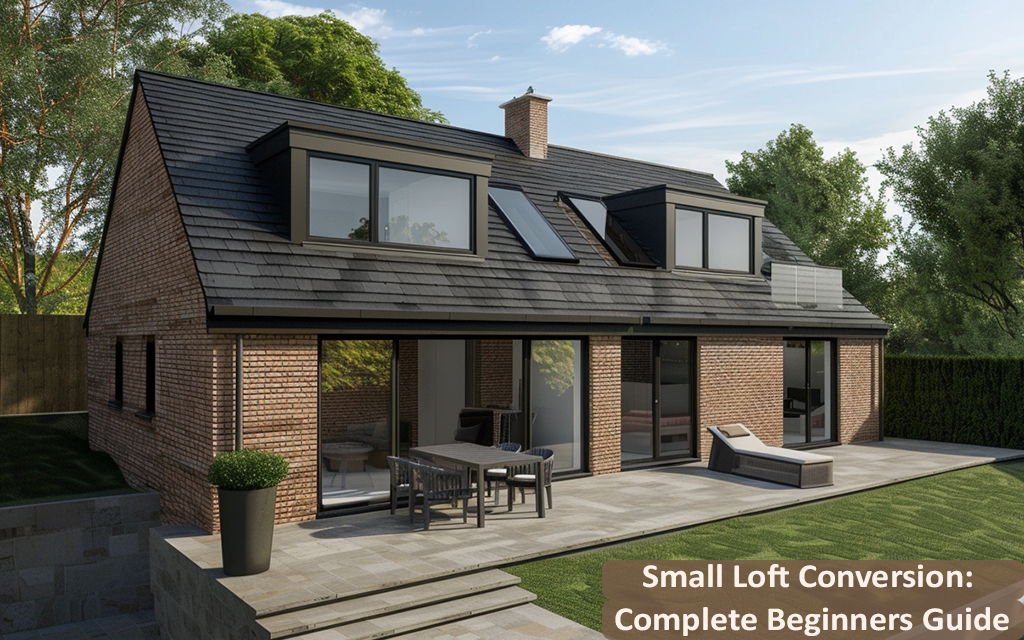Small Loft Conversion Guide – Small Loft Conversions are a very popular way to redefine your limited attic space. Let us read all the essential information about a small-sized loft conversion.
Contact us “TEL Constructions” for flat roof loft conversion services in UK. Call us at 020 8158 4006 Get A Quote Today
Small Loft Conversion Company UK
What is a Small Loft Conversion – A small loft conversion is the process of converting a small unused attic space into a well-utilized loft area. A small loft can be present in any property but is usually seen in homes with limited space. It is generally a smaller-scale loft conversion. You can convert this abandoned area into a beautiful functional space. Be it a bedroom, study room, or a home office; the conversion offers versatile room choices. Besides, the small loft conversions are a perfect alternative to extensions. For homeowners who want an extra room; this is a cost-effective construction. This simple loft conversion process will also renovate your space without causing too much stress on your wallet.
What to Do with the Low Ceiling in Small Attic?
Low Ceilings can raise many issues, especially in small loft conversion projects. There are some ways to face this challenging situation. Let us give you the strategies for a low ceiling in the attic.
- Raise the Attic Roof: It might increase the expenses but is an effective solution to increase the height of a loft. This may also require planning permissions.
- Install Dormer Windows: Dormer windows are flexible. They are specially utilized in low-ceiling attic spaces. You will get a raised ceiling and great ventilation.
- Utilizing Smart Design Solutions: Even if you are not ready for any of the above-mentioned strategies. Go with creativity. Use integrated storage fittings, and a light-coloured interior for a sense of openness.
- Install Velux Balcony Windows: Installing a Velux balcony window is an advanced solution for low ceilings. It includes a window that is attached to the slope and acts like a balcony.
- Talk to a Loft Conversion Expert: So, before making any final decision, you can consult the professional loft conversion expert. They will inspect the space closely. According to the small loft layout, they will tell you the most functional ways.
Benefits of Small loft conversion
- The prime reason is that this loft conversion not only adds space but also increases the property value by a minimum of 20%.
- Design of small loft conversion ideas are increasingly becoming popular in all parts of the UK.
- As long as the loft conversion stays within the limit i.e. adding 40 cu.m. for a terraced home and 50 cu.m. for a detached house, planning permissions are not required.
- The extra space created makes your home more energy-efficient. The roof lights aim for better ventilation and natural light.
- The extra insulation added to the home will help you cut down your utility bills for sure.
Important Rules and Regulations for Small Loft Conversion
Though loft conversion seems a simple project, it needs to be compliant with building codes, planning permissions and various rules. They are important to be followed for a secure, sound and robust construction.
- Planning Permission for Small Loft Conversion – Planning permission is the legal permit for the construction. It depends on the size, scale and location of your property to know if it is needed or not. Generally, a small loft conversion does not require it as it comes under the permitted development right. That means the conversion of a small attic can be carried out without the need to get into the planning permission process. Besides, listed buildings, conservative areas, national parks, and outstanding natural beauty areas surely need to have planning permissions. Such regions are restricted from making any alterations to the buildings. Contact an experienced loft conversion architect. He will guide you comprehensively about it.
- Building Regulations for a Small Loft Conversions Project – Building regulations are independent of planning permissions. These must have to be followed by the structural designs. It ensures the safety, safe access & exits, insulation, ventilation and stability of a building. You must ensure the small loft conversion is adhered to the building regulations. The process is carried out by the local building authority. They inspect the design plans, concepts and layout from the drawings that you submit. Usually, the loft conversion structural engineer you hired will take accountability for this part of the construction.
- Party Wall Agreements for a Small Loft Conversions – Does your small loft share a wall with the neighbours? Then you must need a party wall agreement before the construction process begins. It is required because the conversion can impact the neighbouring wall. And you take the accountability for whatever happens with this agreement. With this party wall agreement, both your loft conversion builders and you ensure the safety of their property. The neighbourhood is given confidence that why will be protected during the entire procedure.
- Structural Integrity, Waterproofing, Energy Efficiency and Fire Safety – No matter the loft size and design; structural integrity is prominent to know if it can carry the additional load. The loft should be properly waterproofed to prevent the consequences of water/ moisture ingress. It can be done by incorporating waterproof roofing. The better the waterproofing, the better the structure’s longevity will be. According to part L of building regulations, a property must have ideal insulation and heating installation. The property should have adequate fire safety measures, emergency exits, fire alarms and fire-resistant doors.
When a small loft space follows all the rules and regulations, the project can be started. Seek the expert loft conversion company to make informed decisions. An expert easily understands structures and provides solutions to make them compliant with the legal building rules and regulations.
Small Loft Conversion Cost in the UK
Before you decide on starting a small loft conversion project, familiarize yourself with the costs. Knowing the approximate cost influences, the decision, style requirement, design and many other things. The starting price for a small loft conversions in the UK is expected around £13,000. Whereas the highest price can go up to around £45,000 or more. The UK loft conversion cost depends on several factors. A personalized small attic conversion installation can increase the expenses. Here are the major factors influencing small loft conversions cost price:
- Size and Design: If the small loft covers more space, or if the roof is expected to be raised, the cost influences. More size will utilize more materials and labour costs. Similarly, the detailing and uniqueness of the design impact the cost. Further, the bespoke small loft conversions are expected to be more costly than generic designs.
- Accessibility to the Loft: Another thing that impacts the cost of a small loft in the UK is its accessibility. If there is complexity here, architects may need to modify it. To make a loft easily accessible adds extra costs.
- Type of Scaffolding Utilized in Project: Scaffolding is a structure that supports workers, and builders. It provides them with a place to stand or sit to proceed. It comes in various forms such as birdcage, independent and cantilever. It is selected depending on the type and complexity of the project. So, the cost is also added to the overall project.
- Material Used and Any Features: Materials play a significant part in making the loft conversion cost. Premium materials offer great durability, and longevity and are luxurious. Thus, they will be costly. Also, additional features such as specialised flooring, windows and decoration impact the cost of a small attic in the UK.
- Location of Your Property: Cost prices can vary according to the region. It might not be much difference in areas which are close to one another. However, material and labour costs in cities are higher than that in rural areas.
Hence, the cost for a small loft conversion service is quite unpredictable. Only the approximate values can be defined. Individuals have different requirements, circumstances and needs; according to which the cost changes.
Feasibility for a Small Loft Conversion
Is your current property feasible for a loft conversion? There are some things to consider before you take the final call for this project.
- Inspecting the Space for a Small Loft Conversion: Start by knowing if your property is healthy enough for a conversion. Check its condition, size, layout and strength. Does your attic have enough space to make a functional room? Observe it and find out if this attic can fulfil your requirements.
- Height Requirements for a Small Loft: Every loft conversion design has the minimum height requirements. It ensures that you will have safe headroom. An ideal headroom height should be around 7 feet or 2.1 meters.
- Trusses in the Attic Space: How much space is occupied by the trusses in your loft? These are the structures that support the loft roof. To convert the small attic, trusses are mostly modified. It can increase the conversion complexity. So, taking into account the presence of trusses, they can elevate the cost as well.
- Overall Structure Condition and Other Fittings: Your attic space may have some damaged spots, it may have rotten or decayed. So, these impact the strength of the attic material. Talk to an expert loft conversion team to know if they could impact the overall durability. Addressing these issues and fixing them can add more cost.
- Staircase Accessibility: Stairs are an important part of a loft. It will make easy access to the small loft conversion. Does the loft have enough space to fit staircases? In small attics, most of the time, ladders are installed. For stairs to comply with the building regulations, some layout adjustments can be required.
Let’s have a look how you can get the best out of the small loft conversion
Making your small loft appear big is all about getting the design right. Connect with the professional small loft conversion companies that will help you deliver the best usable design.
- Don’t ignore large Furniture items – Well, you may think that a large piece of furniture may dominate the room but getting a larger one rules out the need for small items that are required in the periphery. Carefully selecting the furniture helps you mark a maximum impact.
- Go for bespoke units – You need to be innovative while selecting the furniture for your small loft. Rather than buying pre-made, refer going for bespoke ones as they help in minimizing clutter and ensure maximum space utilization.
- Install Dormer Windows – By selectively using dormer windows, you can actually create great living space in your small loft.
- Use Mirrors for more illumination – Small loft conversion designs can be a little dull and turn the space dark. For that, it’s better to maximize the light. Avoid going for heavy and dark shades of furniture or wall paints. Installing mirrors strategically could increase the reflection and hence brightly illuminate the room.
FAQs
Can I Convert My Small Loft?
Yes, if your loft has adequate height, size and structural integrity, a professional loft conversions specialist can convert your small attic space. This can be transformed into a highly functional, bright, safe and comfy room.
Is a Small Loft Conversion Service Worth it?
A small loft conversion is worth a shot, if you have enough expenses, and need the extra head space. With a small loft conversion, you convert an unutilized area into a nicely groomed and practical room. The living space increases, the room can be used in distinctive ways and the property value increases.
How Long Does It Take To Convert A Small Attic Space?
The time for completing a small loft conversion depends on the project scale. How much work an architect and builder need to be done? Is there any modification in the roof? Your loft conversion expert will tell you the project duration.
 19 December 2025
19 December 2025 19 December 2025
19 December 2025 19 December 2025
19 December 2025 19 December 2025
19 December 2025 19 December 2025
19 December 2025



mangat